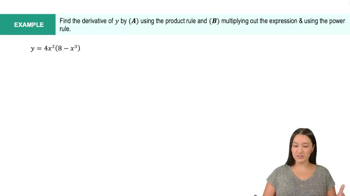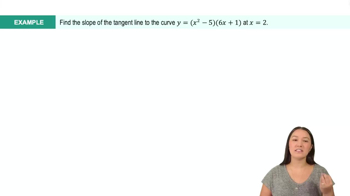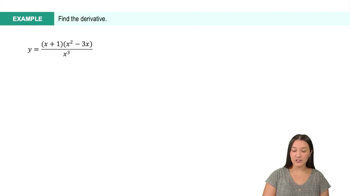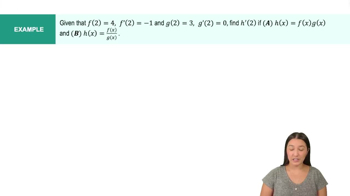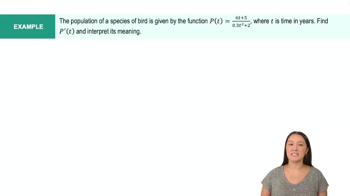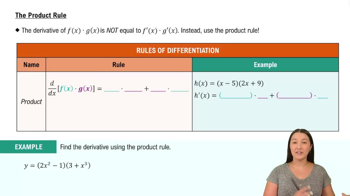Table of contents
- 0. Functions7h 52m
- Introduction to Functions16m
- Piecewise Functions10m
- Properties of Functions9m
- Common Functions1h 8m
- Transformations5m
- Combining Functions27m
- Exponent rules32m
- Exponential Functions28m
- Logarithmic Functions24m
- Properties of Logarithms34m
- Exponential & Logarithmic Equations35m
- Introduction to Trigonometric Functions38m
- Graphs of Trigonometric Functions44m
- Trigonometric Identities47m
- Inverse Trigonometric Functions48m
- 1. Limits and Continuity2h 2m
- 2. Intro to Derivatives1h 33m
- 3. Techniques of Differentiation3h 18m
- 4. Applications of Derivatives2h 38m
- 5. Graphical Applications of Derivatives6h 2m
- 6. Derivatives of Inverse, Exponential, & Logarithmic Functions2h 37m
- 7. Antiderivatives & Indefinite Integrals1h 26m
- 8. Definite Integrals4h 44m
- 9. Graphical Applications of Integrals2h 27m
- 10. Physics Applications of Integrals 2h 22m
3. Techniques of Differentiation
Product and Quotient Rules
Problem 3.R.85b
Textbook Question
Finding derivatives from a table Find the values of the following derivatives using the table. <IMAGE>
b. d/dx ((f(x) / g(x)) |x=
 Verified step by step guidance
Verified step by step guidance1
Step 1: Identify the functions f(x) and g(x) from the table provided. Note their values and any derivatives given at specific points.
Step 2: Recall the quotient rule for derivatives, which states that if you have a function h(x) = f(x)/g(x), then the derivative h'(x) is given by: \( h'(x) = \frac{g(x)f'(x) - f(x)g'(x)}{(g(x))^2} \).
Step 3: Substitute the values of f(x), f'(x), g(x), and g'(x) at the point x = a from the table into the quotient rule formula.
Step 4: Simplify the expression obtained in Step 3 by performing the necessary arithmetic operations.
Step 5: Ensure that the denominator (g(x))^2 is not zero at x = a to avoid division by zero, and verify the final expression for correctness.
 Verified video answer for a similar problem:
Verified video answer for a similar problem:This video solution was recommended by our tutors as helpful for the problem above
Video duration:
4mPlay a video:
Was this helpful?
Key Concepts
Here are the essential concepts you must grasp in order to answer the question correctly.
Derivatives
A derivative represents the rate of change of a function with respect to a variable. It is a fundamental concept in calculus that provides information about the slope of the tangent line to the curve of the function at any given point. Understanding how to compute derivatives is essential for analyzing the behavior of functions.
Recommended video:

Derivatives
Quotient Rule
The Quotient Rule is a formula used to find the derivative of a function that is the ratio of two other functions. Specifically, if you have a function h(x) = f(x) / g(x), the derivative h'(x) is given by (g(x)f'(x) - f(x)g'(x)) / (g(x))^2. This rule is crucial when dealing with derivatives of fractions.
Recommended video:
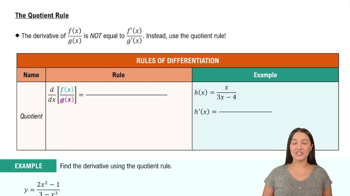
The Quotient Rule
Evaluating Derivatives at a Point
Evaluating a derivative at a specific point involves substituting the value of the variable into the derivative function. This process provides the slope of the tangent line to the function at that particular point, which is important for understanding the function's behavior in that vicinity.
Recommended video:

Critical Points
Related Videos
Related Practice



